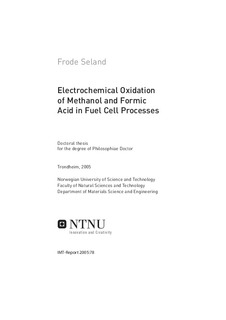| dc.description.abstract | The main objectives of the thesis work were: (1), to study the oxidation of methanol and formic acid on platinum electrodes by employing conventional and advanced electrochemical methods, and (2), to develop membrane electrode assemblies based on polybenzimidazole membranes that can be used in fuel cells up to 200 °C.
D.c. voltammetry and a.c. voltammetry studies of methanol and formic acid on polycrystalline platinum in sulphuric acid electrolyte were performed to determine the mechanism and kinetics of the oxidation reactions.
A combined potential step and fast cyclic voltammetry experiment was employed to investigate the time dependence primarily of methanol oxidation on platinum. Charge measurements clearly demonstrated the existence of a parallel path at low potentials and short times without formation of adsorbed CO. Furthermore, experimental results showed that only the serial path, via adsorbed CO, exists during continuous cycling, with the first step being diffusion controlled dissociative adsorption of methanol directly from the bulk electrolyte. The saturation charge of adsorbed CO derived from methanol was found to be significantly lower than CO derived from formic acid or dissolved CO. This was attributed to the site requirements of the dehydrogenation steps, and possibly different compositions of linear, bridged or multiply bonded CO. The coverage of adsorbed CO from formic acid decreased significantly at potentials just outside of the hydrogen region (0.35 V vs. RHE), while it did not start to decrease significantly until about 0.6 V vs. RHE for methanol. Adsorbed CO from dissolved CO rapidly oxidized at potentials above about 0.75 V due to formation of platinum oxide.
Data from a.c. voltammograms from 0.5 Hz up to 30 kHz were assembled into electrochemical impedance spectra (EIS) and analyzed using equivalent circuits. The main advantages of collecting EIS spectra from a.c. voltammetry experiments are the ability to directly correlate the impedance spectra with features in the corresponding d.c. voltammograms, and the ability to investigate conditions with partially covered surfaces that are inaccessible in steady-state measurements.
A variety of spectral types were observed, and for methanol these showed only a single adsorption relaxation aside from the double-layer/charge-transfer relaxation, though some structure in the phase of the latter relaxation hints at another process. The charge-transfer resistance showed Tafel behaviour for potentials in the rising part of the oxidation peak consistent with a one-electron process in the rate-determining step. The rate limiting step was proposed to be the electrochemical reaction between adsorbed CO and OH at the edge of islands of OH, with competition between OH and CO adsorption for the released reaction sites. Only a single adsorption relaxation in methanol oxidation was observed, implying that only one single coverage is required to describe the state of the surface and the kinetics. It was assumed that this single coverage is that of OH, and all the surface not covered with OH is covered with CO so that the coverage of CO is not an independent variable. Inductive behaviour and negative relaxation times in the methanol oxidation were attributed to nucleation and growth behaviour. Linear voltammetry reversal and sweep-hold experiments also indicated nucleation-growth-collision behaviour in distinct potential regions, both in the forward and reverse potential scan for methanol oxidation on platinum.
In both methanol oxidation and formic acid oxidation, a negative differential resistance (NDR) was observed in the potential regions that possess a negative d.c. polarization slope, and was attributed to the formation of surface oxide which inhibited the oxidation of methanol or formic acid.
EIS spectra for formic acid clearly showed the presence of an additional low frequency relaxation at potentials where we expect adsorbed dissociated water or platinum oxide to be present, implying that more than one single coverage is required to describe the state of the surface and the kinetics. Two potential regions with hidden negative differential resistance (HNDR) behaviour were identified in the positive-going sweep, one prior to platinum oxide formation, assumed to involve adsorbed dissociated water, and one just negative of the main oxidation peak, assumed to involve platinum oxide. Oscillatory behaviour was found in the formic acid oxidation on platinum by adding a large external resistance to the working electrode circuit, which means that there is no longer true potentiostatic control at the interface. By revealing the system time constants, impedance measurements can be used to assist in explaining the origin of the oscillations. In the case of formic acid, these measurements showed that the oscillations do not arise from the chemical mechanism alone, but that the potential plays an essential role.
Preparation and optimization of gas-diffusion electrodes for high temperature polymer electrolyte fuel cells based on phosphoric acid doped polybenzimidazole (PBI) membranes was performed. This fuel cell allows for operating temperatures up to 200 °C with increased tolerance towards catalytic poisons, typical carbon monoxide. In this work we employed pure hydrogen and oxygen as the fuel cell feeds, and determined the optimum morphology of the support layer, and subsequently optimized the catalytic layer with respect to platinum content in the Pt/C catalyst and PBI loading. A smooth and compact support layer with small crevices and large islands was found to be beneficial with our spraying technique in respect to adhesion to the carbon backing and to the catalyst layer. We found that a high platinum content catalyst gave a significantly thinner catalyst layer (decreased porosity) on both anode and cathode with superior performance. The PBI loading was found to be crucial for the performance of the electrodes, and a relatively high loading gave the best performing electrodes. | nb_NO |
